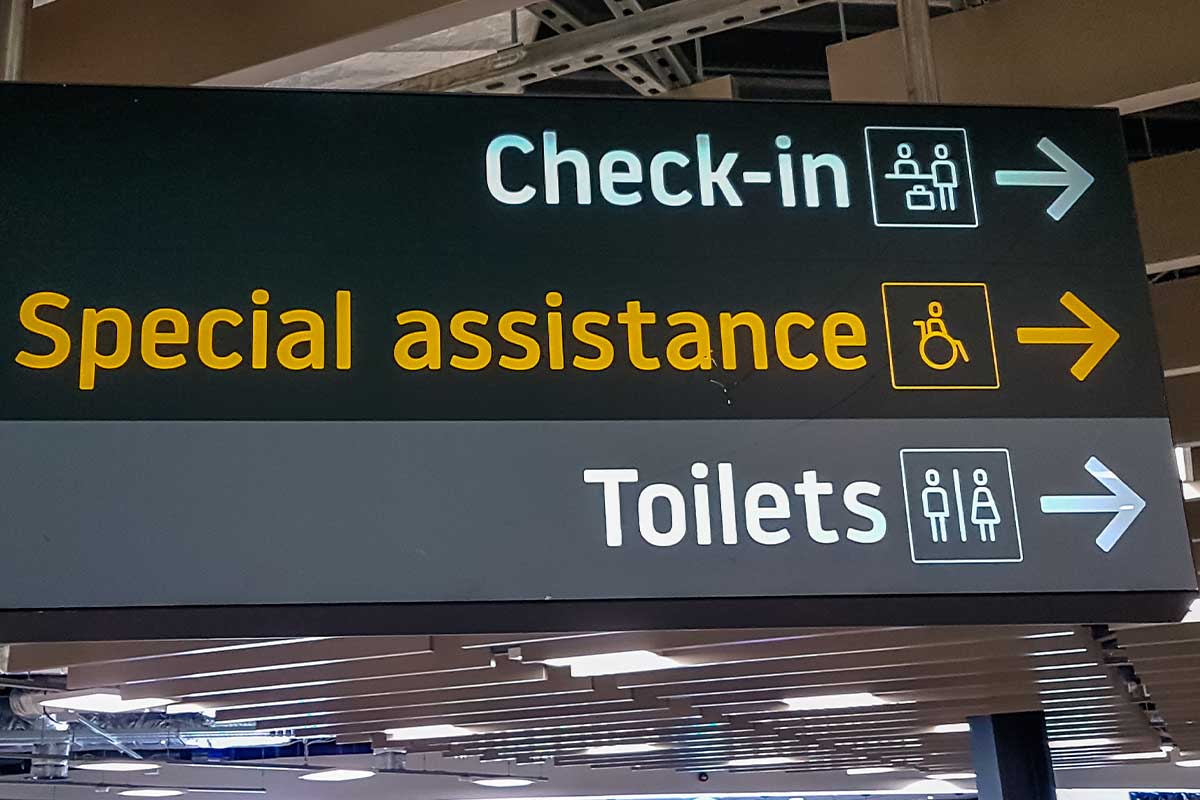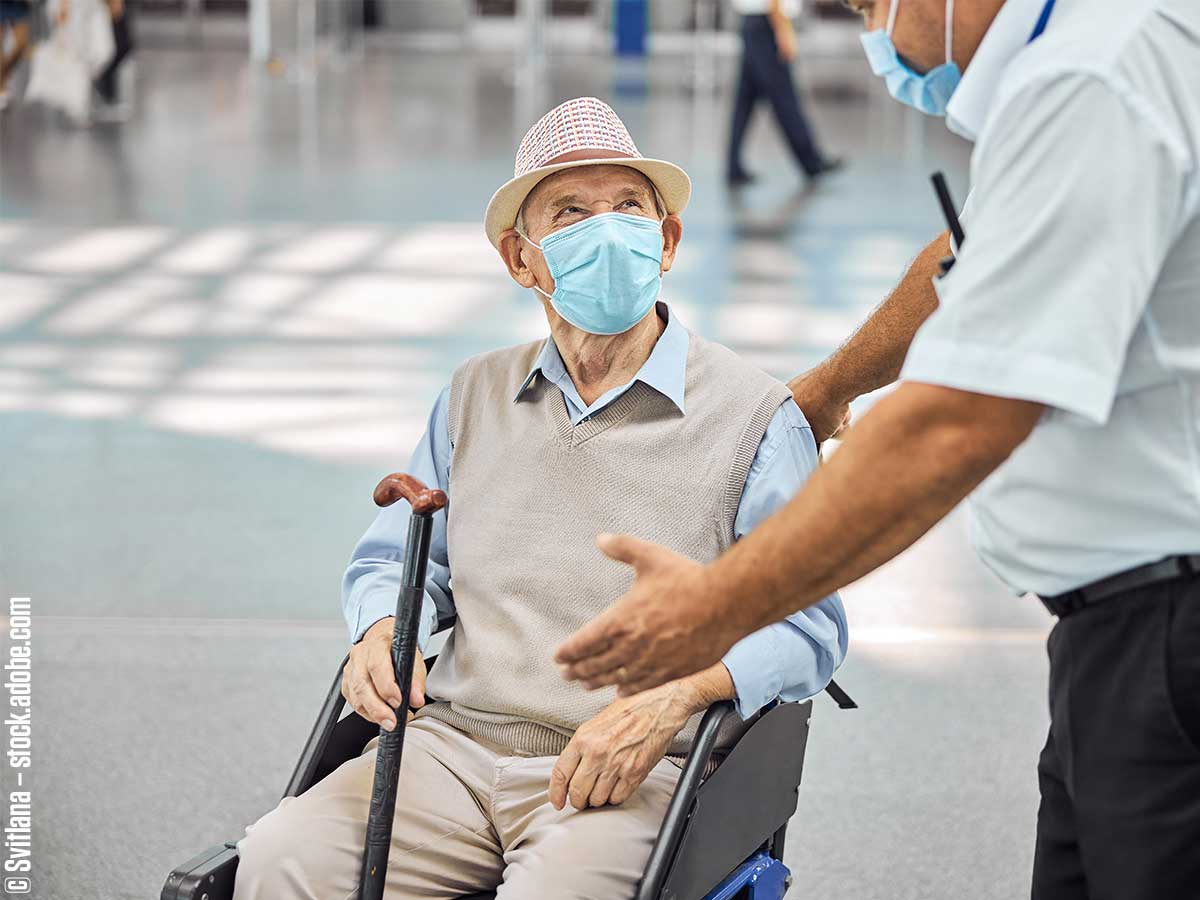When considering provision of disability services at airports it is important to answer what appears to be a simple question. How is disability defined? Disability is made up of several dimensions, including mobility, sensory, communication, intellectual/mental health and hidden disabilities [1]. Aviation often relies on the acronym ‘PRM’ (Person with Reduced Mobility). This term does not fully encompass the range of needs that airports, airlines and service providers need to support. In fact, research has found that 70% of people with disabilities in the UK have hidden disabilities [2].
Passengers with disabilities (as defined above), are one of the fastest growing demographics in commercial air travel, with many airports seeing annual growth in this category exceeding six times the overall rate of passenger growth[3]. Despite this significant growth, and many years in which to perfect their service offering, airports still present multiple challenges for passengers with disabilities. Social exclusion from transport is still the reality for many[4], despite over one billion people globally experiencing some form of disability[5]. Access to aviation for all is vital to enable everyone to access the economic and social benefits of air transport.
The World Health Organization and World Bank define the travel chain as “all elements that make up a journey, from starting point to destination – including the pedestrian access, the vehicles, and the transfer points”. If any link is inaccessible, the entire trip becomes difficult[6]. When the travel chain is applied to aviation, is clear to see how complex a journey can be for some passengers with disabilities. Several aspects of the process can be particularly difficult, including the transfer from surface access, security processes, aircraft boarding/disembarking and access to toilet facilities. Airports face the challenge of making this process seamless, while contending with a modern system which operates on low margins and with short turnaround times.
 Airport surface access can be made up of several modes of public transport, as well as car parking and drop off points. This step of a passenger’s journey is often not adequately covered by airport’s disability services provision. If this early stage of the travel chain is disrupted, the rest of the journey becomes more challenging for the passenger and could leave them with a negative perception of the airport. The range of access methods are not the only challenge, as different types of disabilities need varying levels of support. A passenger who needs wheelchair assistance may need support from arrival at a drop off location, which can often be located far away from the terminal building. Another passenger with a visual impairment could arrive at an airport taxi rank and need support to safely reach the terminal building.
Airport surface access can be made up of several modes of public transport, as well as car parking and drop off points. This step of a passenger’s journey is often not adequately covered by airport’s disability services provision. If this early stage of the travel chain is disrupted, the rest of the journey becomes more challenging for the passenger and could leave them with a negative perception of the airport. The range of access methods are not the only challenge, as different types of disabilities need varying levels of support. A passenger who needs wheelchair assistance may need support from arrival at a drop off location, which can often be located far away from the terminal building. Another passenger with a visual impairment could arrive at an airport taxi rank and need support to safely reach the terminal building.
Airports vary in their approaches to supporting surface access for people with disabilities. A significant number of airports don’t provide any kind of assistance until the passenger has reached a dedicated Person with Reduced Mobility (PRM) desk or the check-in area. Some airports have chosen to offer dedicated help points where passengers can request assistance. However, these often don’t adequately cover all possible surface access points. This could lead to exclusion from public transport, or prevent independent travel for people with certain disabilities.
Could improved technology help?
This current approach to assisting passengers from surface access points to the terminal building is very basic- could technology improve this process? A passenger needing assistance could arrive at any access point with a variety of needs, this can’t be solved by assigning a specific drop off point. Recent innovations include the introduction of a mobile app called PRM Assist at a number of airports including Bristol, Cork and Donegal. The app allows a passenger to specify their exact needs to the airport well in advance, allowing airports to plan how they can best support. Passengers can also give instant feedback on their experience to allow service providers to deal with any issues promptly.
The app does not yet support passengers with surface access, but already utilises location services, which can accurately report the live location of a passenger. It could be possible for a passenger to indicate their expected access point and time of arrival and their specific needs, such as being met by a wheelchair. Passengers that pre-notify the airline of their requirements benefit from the fact that airports and service providers are notified and prepared on both ends of the process. However, the integration of location based services could allow the airport to better support the passenger, by ensuring that the right support is in the right place at the right time. On top of this, technology could be implemented which could allow a passenger to track the location of assistance staff or what the current wait time is at PRM security lanes. Technology which allows greater visibility and tracking is already widely adopted in other areas such as ride hailing apps. This would not necessarily be expensive to implement- as my colleague Irene outlined in a previous blog.
 Another area that prevents an equal travel experience is the guidance that passengers should notify the airline of their requirements 48 hours before departure[7]. This guidance could prevent passengers that need assistance from travelling when they wish / need to travel at short notice. Modern airport management solutions such as total airport management (TAM) could greatly improve passenger experience. TAM allows for dynamic planning and allocation of fixed and mobile resources in both the airside and landside environments. This can also include the resources of PRM providers, which could allow for a seamless experience for passengers who couldn’t notify in advance of the 48 hour period.
Another area that prevents an equal travel experience is the guidance that passengers should notify the airline of their requirements 48 hours before departure[7]. This guidance could prevent passengers that need assistance from travelling when they wish / need to travel at short notice. Modern airport management solutions such as total airport management (TAM) could greatly improve passenger experience. TAM allows for dynamic planning and allocation of fixed and mobile resources in both the airside and landside environments. This can also include the resources of PRM providers, which could allow for a seamless experience for passengers who couldn’t notify in advance of the 48 hour period.
Surface access and landside terminal processes form one of the first stages of the air travel chain. It is imperative that airports offer smooth and inclusive support for passengers with disabilities to allow all passengers to have a consistent experience. If this step isn’t managed effectively, passengers could face a difficult and stressful experience, no matter how good service provision is later in their journey. Airports are yet to embrace technology to improve this important stage of the passenger journey, and in doing so, could vastly improve experience and provide a more seamless journey for all.
Providing an effective service for passengers with disabilities is one of the major challenges facing the aviation industry. Here at Think we can help you improve performance with process design and optimisation, simulation and modelling tools, scenario planning and investment appraisal. Get in touch if you require support with any aspects of disability services provision.

Author: Joe Wildman, Analyst, Think Research
References
[1] Darcy, S., & Buhalis, D. (2011). Conceptualising Disability: Medical, Social, WHO ICF, Dimensions & Levels of Support Needs. Accessible Tourism: Concepts and Issues. https://www.researchgate.net/profile/Simon-Darcy/publication/292258453_Conceptualising_disability/links/5edcb76f92851c9c5e8b0c49/Conceptualising-disability.pdf.
[2] Brookes, S., Broady, R., & Calvert, L. (2008). Hidden Disabilities: Preliminary report. Centre for Disability Studies- University of Leeds. https://disability-studies.leeds.ac.uk/wp-content/uploads/sites/40/library/brookes-NUJ-Hidden-disabilities-Report-plus-Lena.pdf.
[3] European Regions Airline Association. (2018). Passengers with Reduced Mobility (PRMs). https://www.eraa.org/sites/default/files/180924_th_era_prm_brochure_online.pdf
[4] Hine, J., & Mitchell, F. (2016). Transport disadvantage and social exclusion. Routledge.
[5] International Air Transport Association (IATA). (2022). Why Accessibility is Essential for Air Travel. https://www.iata.org/en/publications/newsletters/iata-knowledge-hub/why-accessibility-is-essential-for-air-travel/
[6] World Health Organization., & World Bank. (2011). World Report On Disability. https://documents1.worldbank.org/curated/en/665131468331271288/pdf/627830WP0World00PUBLIC00BOX361491B0.pdf
[7] European Union. (2022). Rights for travellers with disabilities or reduced mobility. https://europa.eu/youreurope/citizens/travel/transport-disability/reduced-mobility/index_en.htm#plane


Recent Comments